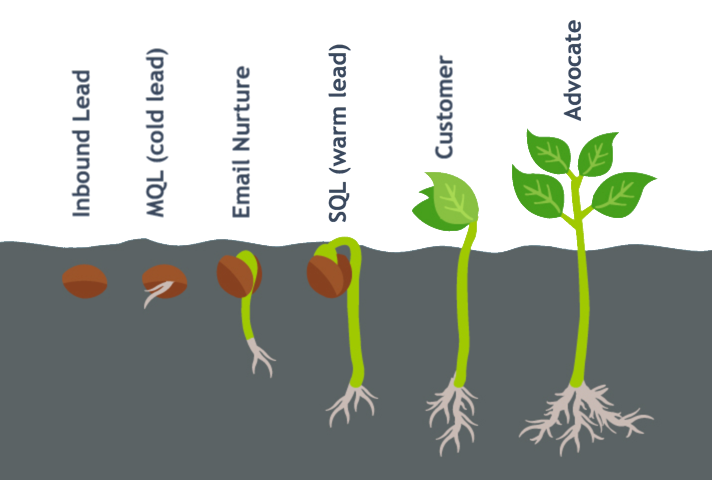Let’s face it… the only thing we really care about as B2B marketers is generating leads for our sales team.
We sit in meetings and report on what we’ve contributed to the bottom line. Marketing is no longer just branding, it’s about tangible results, and we’re on a mission to generate as many marketing-attributed leads as possible.
That said, B2B lead generation can be hard, and to make things worse there’s a lot of bad information out there. People telling you to buy email lists and getting the sales team to make cold calls isn’t helpful.
This article is going to put a stop to the stone-age approach and layout how B2B companies should be generating leads through digital marketing in 2022.
First things first, what is lead generation?
Lead generation is the process of attracting and converting strangers and prospects into someone who has indicated an interest in your company’s product.
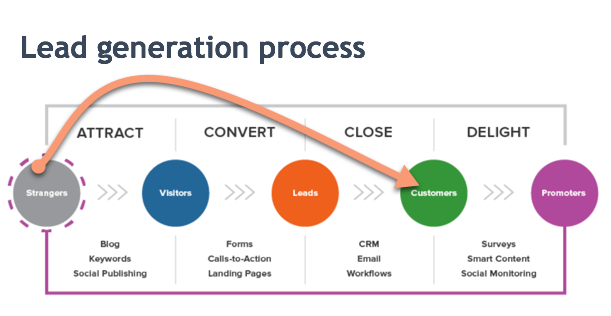
Simply, it’s about converting someone who has never heard of your company, into a customer. This is commonly referred to as ‘Inbound Marketing’.
But like most things, generating leads isn’t black and white. Some leads may purchase immediately, some may be interested but have no demand, and some may never be interested to buy.
This is where marketing and sales teams can fall out. Marketing end up passing all inbound ‘leads’ over and the sales team come up empty-handed. This is simply because the majority of leads are not ready to talk to sales. In fact, only 27% of the leads sent over to sales people are properly qualified.
To avoid this problem leads can be categorised into two groups:
Marketing qualified leads (MQL)
A MQL is a relevant lead which is not ready to be sold to. This user may have downloaded an ebook or attended a webinar so you know they’re invested in your industry, but they are not yet in the market to buy.
MQLs make up the vast majority of inbound leads, so it’s no wonder why many marketing teams get labelled as providing ‘rubbish leads’ when they’ve been passing them over to early. Just because you’ve downloaded an ebook, doesn’t mean you’re ready to buy a new software solution…
Sales qualified leads (SQL)
A SQL, on the other hand, is a lead which has the intent to buy. These leads are actively looking to purchase and could have requested pricing or a product demo. These are prime leads for the sales team to convert into customers.
More importantly, these are the leads sales are happy to see in their inbox.
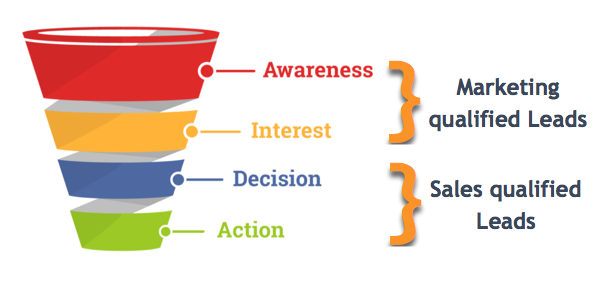
Why not always go for SQL leads?
You’re probably thinking, why don’t I just attract ready-to-buy leads? It would save me loads of time and make me mega-popular with the sales team.
In an ideal world this would be the case, but the truth is that 98% of your leads are not ready to purchase on the first visit. So if you’re only focusing on leads who are ready-to-buy, you’re leaving A LOT of money on the table.
The following focuses on a simple process you can use to attract MQL’s and turn them into the SQLs you’ll love.
B2B Lead generation starter kit
Before you can start reeling in the leads, there are a few things you need to get you started.
1. Customer persona: like any good marketing campaign, you need to start by defining who you want to target. If you can’t picture your ideal customer, how can you be expected to attract them? A good persona uses a data-driven approach to discover the biggest pain points of your customer, their gaps in knowledge, and how they consume information. If you haven’t got one already, here’s a great guide to persona creation.

2. Content: once you’ve chosen a persona, next craft a piece of content to solve one of their business challenges, or fill a gap in their knowledge. This content can take many forms:
– ebooks
– webinars
– Podcasts
– Free software
– Whitepapers
– Video series
… the list goes on.
Creating content your readers love isn’t always easy, especially in B2B. If you’re struggling to come up with a topic your audience will genuinely love – follow this guide on how to write content in boring B2B industries.
Here’s an example of an ebook we created at b2bMetric for our readers:
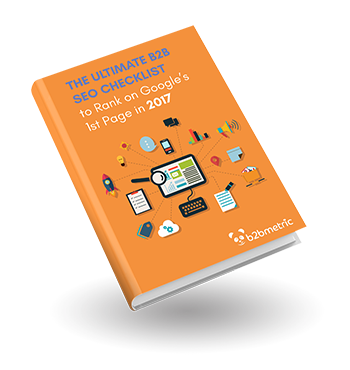
3. Landing page: once your content is identified and created, you’ll need to build a dedicated landing page for it to sit on. This page outlines the incentive of why the reader should give up their email address in order to receive the free resource.
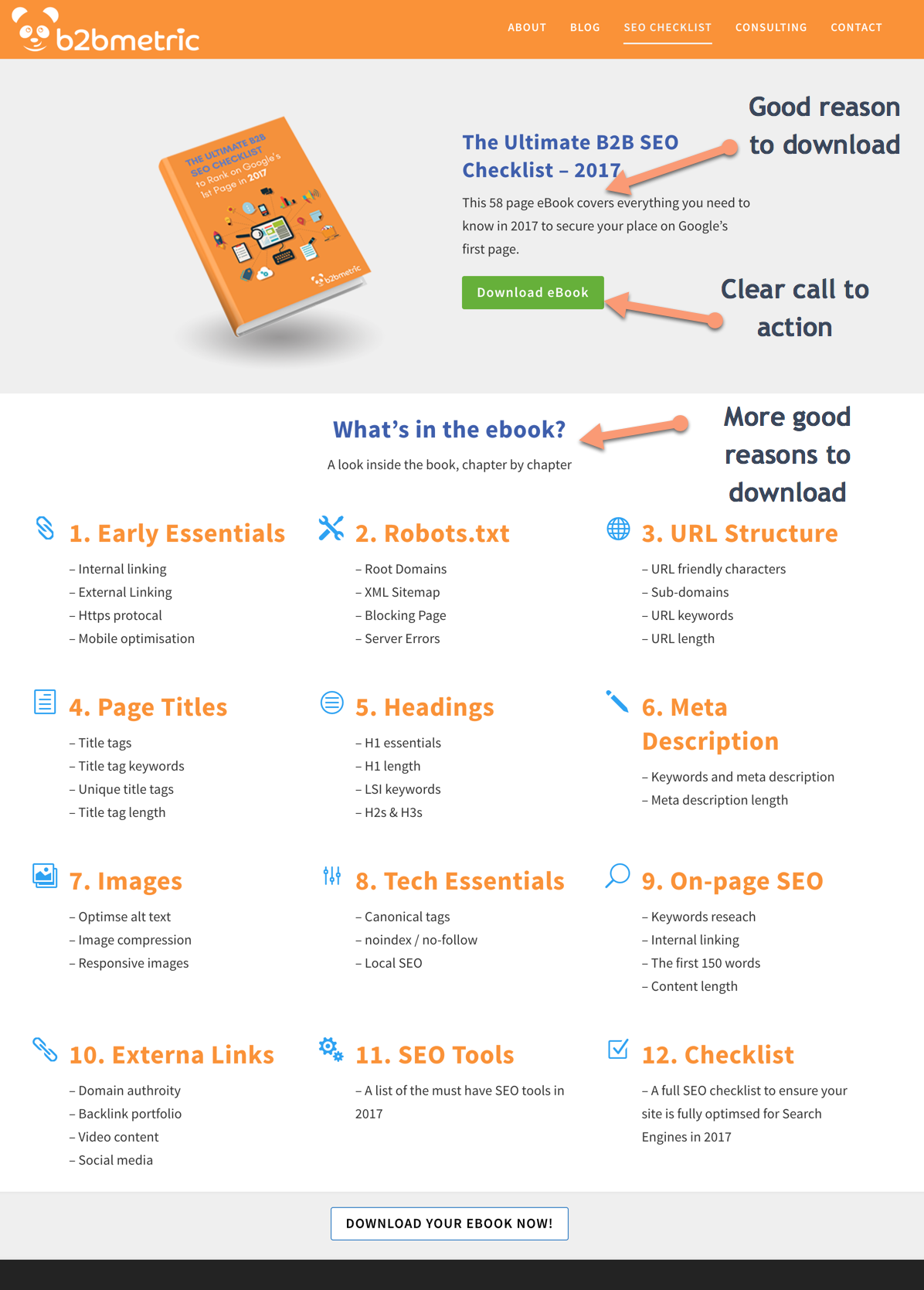
As you can see, this ebook isn’t a run of the mill blog post. It covers every aspect a B2B marketer needs to know in order to rank highly in Google Search. The job of the landing page is to illustrate its value to the reader so they hit ‘download’.
4. Form and call to action (CTA): now you’ve got your landing page sorted you need a way to gate your content. Gating simply means users need to enter their email address before downloading the asset. The action of filling out the form is what converts them from a browser to a MQL.
Driving leads to your landing page.
So you’ve got your lead magnet and landing page sorted. All you need now is traffic. Here are two of the best lead generation tactics used by B2B marketers to drive highly relevant leads to your landing page.
Search Marketing
Generating MQLs using PPC is often overlooked. Instead, B2B marketers use AdWords to target companies immediately ready to buy. This can work, but as mentioned if you only target these leads, you’ll leave a lot of money on the table.
Companies like Wordstream have figured out that while the majority of their competitors are promoting ‘sales focused’ ads using AdWords, they’ve taken a different route and promote ‘research focused’ ads.
For example, if I type ‘landing page best practices’ into Google I see the following results:

The top results are instantly trying to sell me services. But Wordstream has noticed that my search query isn’t a ready-to-buy one. Instead, they’ve offered me an outlet for more information. Once I click on the ad I’m presented with the following landing page:

They’ve now received my personal information and I’m officially a MQL for Wordstream. On the other hand, their competitors have lost the opportunity to turn me into a lead because they were pushing for the instant sale.
Take away: while pursuing SQL using Adwords can be lucrative, you need to ensure you are only promoting ‘sales focused’ ads when consumers are looking for them. If the consumer is looking for information, don’t waste your budget trying the hard sell. Instead, generate an MQL using ‘research focused’ content…. like Wordstream.
Social media
There’s always been a big question mark over the success of social media in B2B lead generation. There have been ‘studies’ which show how ineffective it is, like this one:

And some which suggest it’s very effective, like this one:
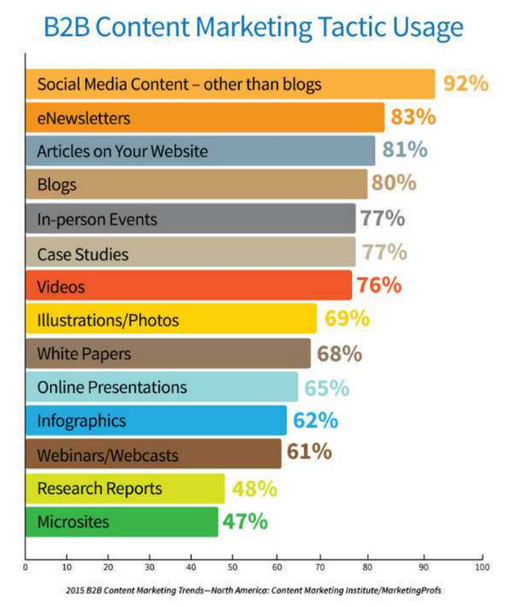
The truth lies with how B2B companies use their social accounts. Companies that frequently upload self-promotion posts are going to fall short. On the other hand, companies that direct both organic and paid social traffic towards their free asset pages are going to drive many more leads.
LinkedIn is the B2B goldmine. With over half a million daily active users, LinkedIn is ideal for getting your content in front of a highly relevant audience. Just like paid search, Linkedin may not be the cheapest advertising platform. But we’re not looking for cheap leads. We’re looking for relevant leads and future customers.
The great thing about LinkedIn ads is how granular you are able to target.
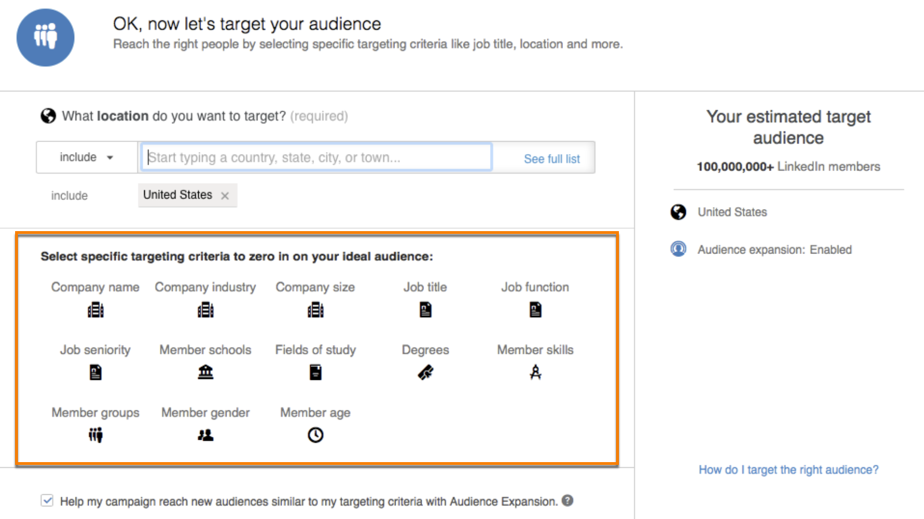
You can target by company, industry, job function and even seniority – which is why 79% of B2B Marketers view LinkedIn as an effective source for generating B2B MQL leads.
Take away: LinkedIn ads are a great way of generating MQLs from relevant companies. Just remember not to go straight for sale, instead, direct them towards your value-adding landing page to convert.
You’ve now got a flurry of relevant MQLs coming in and It’s too early to them over to the sales team, so what can you do?
Lead Nurturing (turning MQLs into SQL’s)
Lead nurturing, simply put, is the building of relationships with MQL’s who are not currently ready to buy. Its goal is to educate the prospect and build trust, so when the time comes to buying they think of you.
The obvious: email nurture streams
The guys over at Demand Gen Report found that nurturing leads through automated email streams increased opportunities by 30%. This is due to the fact that MQL’s need upwards of 5 touchpoints from a company before they convert into a customer.
Automated email streams are simply pre-programmed emails that trigger when a lead has downloaded content from your website. It’s a great way for small companies to achieve these 5 touchpoints, without having a massive sales team.
Take this example of a small lead nurturing sequence, which acts as a mechanism to drive leads automatically down the sales funnel.
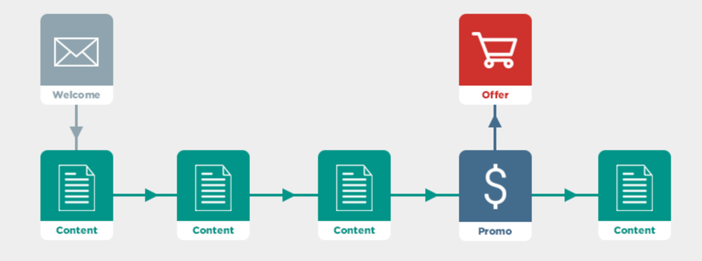
Although brief, it illustrates how powerful automatic emails can be in passively guiding customers towards an eventual purchase. It ticks along in the background and slowly encourages the MQL’s to engage with your company, thus converting them into a beloved SQL.
Email streams are a whole topic in itself, so in the interest of staying on point, here are some great resources for creating email B2B nurture streams that convert MQLs to SQLs:
– B2B Email Drip Campaign Ideas and Examples
– 7 Steal-Worthy Drip Campaign Examples (And Why They Work)
– 7 Lessons from Top-Performing Drip Email Campaigns
Making it multichannel
In the past, nurture campaigns solely consisted of email marketing. Today marketers are able to go beyond the limits of email and use a mixture of remarketing, social media and dynamic website content to achieve better results.
If you’ve received someone’s email address, there is much more you can do with it than simply send them an email. Ad platforms like Facebook and Linkedin allow you to upload email addresses which are matched to user’s profiles. You can then target ads to those specific users.
If you’re unsure of how this works, check out this video on LinkedIn Matched Audiences (38 seconds in).
You’re now able to target information to your MQLs across several channels. And so long as you’re providing them with relevant and insightful content, they’re being navigated towards your product.
Awesome.
Here are a few of the best posts on lead generation strategies:
– What is Lead Nurturing? (& How to Do it Right)
– How to Nurture Your Organic Leads
– B2B Lead Nurturing For Dummies
Conclusion
Lead generation and nurturing have proven to be a scalable and effective strategies. However, it’s not always a quick process. From the first interaction a customer has with your company, it takes time for them to build the trust needed to become an eventual customer. It happens almost without them knowing it.
Your job as a marketer is to:
- Identify what content will lead the customer finding your company for the first time,
- Find ways to successfully promote that content,
- Work out which content you can provide to nurture them from first time visitor through to a customer.
A lot of work needs to be done in the background before you see any tangible benefits.
